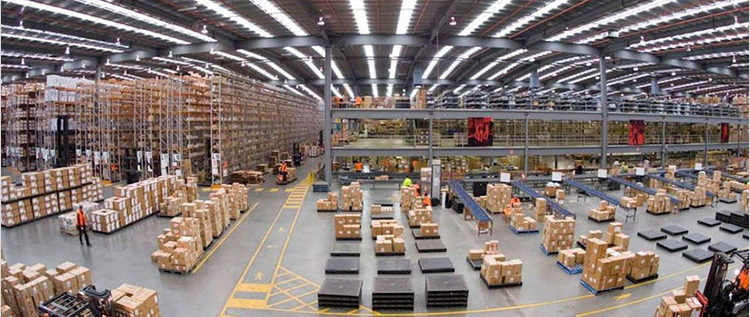E - PAPER
COMMERCIAL REALTY INVESTING: TRENDS & INSIGHTS
In the current volatile times, commercial real estate has emerged as a safe bet for the investors. Industry experts consider the pandemic a short term hiccup and predict a bullish run for the commercial realty in coming days. According to a recent JLL report
 BY
Realty Plus
BY
Realty Plus
Published - Tuesday, 07 Sep, 2021

In the current volatile times, commercial real estate has emerged as a safe bet for the investors. Industry experts consider the pandemic a short term hiccup and predict a bullish run for the commercial realty in coming days.
According to a recent JLL report, India’s net office absorption stood at 4.39 million sq. ft in the Q2, showing 32% YoY growth in major cities. Due to lockdowns across the country in the second quarter, net absorption dipped by 16% versus the previous quarter. However, the quarter-on-quarter drop was lower than the 61% during the same period last year.
As per Savills analysis, the first half of 2021 saw roughly 41% of the investment inflows seen in the full year of 2020, indicating that investor confidence is still high. Commercial real estate is proving to be an attractive investment option for both individual and institutional investors and private equity inflows into the commercial market have been increasing.
An Anarock report says that 7,400 office leases of 90 million sq ft is up for renewal in the top 6 cities in 2021 which is the highest lease expiry pipeline compared to the next two years – 2022 and 2023 across these cities. Year 2022 will see nearly 7,000 leases for approx. 78 mn sq ft come up for renewal, and approx 4,200 leases for over 55 mn sq ft in 2023. However, as many IT firms are considering stepping up their overall business post the pandemic and are currently hiring workforce which bodes well for the sector.
Knight FrankFICCI-NAREDCO Real Estate Sentiment Index Q2 2021 states that bulk hiring by these firms will influence demand for large quality office spaces thus creating a progressive outlook for commercial office market in Q2 2021, for both leasing and rentals.
According to CBRE’s 2020 Global Occupier Sentiment Survey, the importance of physical office space is likely to remain solid. 38% of respondents said that the physical office space will remain as important, if not more. Additionally, 70% of the survey respondents were also confident about setting long-term real estate strategies amid the pandemic.
As the industry reports indicate, commercial real estate seem to continue to attract investors looking for assured higher returns. Commercial properties typically have an annual return of the purchase price between 6% and 12%, depending on the location and overall economic and market factors. Combined with the hiring spree by the tech companies in past few months, an upsurge in the overall office space demand in 2022 and 2023 is expected leading to , increase in volumes of deals and transactions.
FUND RAISING & INVESTMENT STRUCTURING
Commercial realty has been the shining star of Indian realty. Despite the disruptions, confidence of global occupiers in Indian commercial real estate has not shaken as is evident in the recent foreign investments that have doubled especially in the renewed intelligent and contactless work spaces. Neeraj Bansal, Partner & COO, India Global, KPMG in India stated, “Data centres and warehousing are bringing in a lot of international investors. Moreover, the corporates too have not given up on their expansion plans amid the pandemic and would require office space for the increased workforce immediately post Covid. Space demand from numerous unicorn start-ups too have fuelled the demand in commercial realty especially for flexi-workspaces. India's inventory of flexible office space is thus expected to grow 10 to 15% annually over the next three years. The annual warehousing transactions in top 18 cities will more than double to 76 million square feet by March 2026. Data centre market presents a strong investment opportunity of more than 5 billion by 2025 with non-metro cities playing an important role in growth projections.”
Vinod Rohira, CEO, Mindspace Business Parks REIT added, “"There is a phenomenal opportunity for organized players as well as a huge supply flowing in the market. Cost of capital is coming down and Grade A real estate players will see a great amount of opportunities coming towards them. With the fast paced vaccination in urban India, the workforce will resume office spaces soon. In addition, large global investors have a certain mind-set on what they want in specific asset segments and keep a pulse of the market. That is the reason, REIT's gained a lot of interest from big investors as they were well aware about its prospects.”
Yash Gupta, Founder & Managing Partner, YGR expressed that 30 percent of the commercial real estate market belongs to big companies who own approximately one million square feet of IT parks and 70 percent of the market belongs to MSME's, start-ups and other small scale businesses. “Small and medium firms were affected due to the pandemic. This will lead to dislocation in this segment wherein we will see developers and operators acquiring commercial properties at interesting values and locations that were not seen or considered pre pandemic. The pandemic has also given us an opportunity to upgrade, redesign and reimagine the way we look at developing and operating the commercial spaces, which will definitely be more lean and efficient going forward."
Vinamra Srivastava, CEO, Business Parks, India – CapitaLand was of the view that both Grade A and B property developers will now endeavour to improve the product quality and also scale-up to cater to the new demands. “Pushing harder for sustainability, ensuring technology initiatives to ensure health and safety and for operational efficiency & customer experience are some of the changes already happening in this sector. Investment opportunity for institutional players in commercial segment can be divided in two segments - Greenfield development or acquiring ready assets, and both continue to have challenges. For a Greenfield development, identifying the right land and deploying capital requires careful feasibility study. While acquiring a ready asset, technical due diligence and ensuring clarity on Building Permits/NOCs/Approvals is essential.
Arshdeep Singh Sethi, Managing Director- Executive Board, RMZ Corp added that in the present scenario, tier-1 cities offer the best investment opportunities in terms of commercial properties. “The major cities have shown a significant micro market growth, for instance Bengaluru where the micro markets across the city are growing with great results. Tier 1 cities continue to have the largest absorption of offices and with infrastructure development tier 2 cities will gradually become attractive markets in few years.”
According to Ambar Maheshwari, CEO, Indiabulls Asset Management Co. Ltd within cities, the overall vacancy was higher in the central business districts as compared to secondary and tertiary business districts. One of the key reasons being the arbitrage between the rentals and fit out spaces. “Secondary or tertiary business tenants were far pickier because of lower rentals. In the last few months we noticed the margin had expanded for the IT sector. The investment in infrastructure depends on how quickly the GDP grows and it will drive the pace of tier 1 and 2 cities development."
Khair Ull Nissa Sheikh, Executive Director, WTC Services & Board Member of WTCA agreed, "Indian real estate has become more consolidated organized and with economic recovery, recalibration of office space will happen. Logistics and industrial realty segments were most resilient to the disruptions and retail sector will regain speedily once lockdowns are lifted. For domestic and foreign investors, alternative investment is becoming more relevant than before. Commercial real estate gets more investment because the assets are classified as yield generating assets. Tier 1 cities with more grade A buildings garner more investments but with government focus on infrastructure development, tier 2 cities too will become a favourable commercial realty destination. For instance, many companies are moving to GIFT city in Gujarat and Greater Noida. A PWC report highlights that investments in commercial real estate in Delhi NCR with regard to new office space buying are rising by around 30% annually, especially in Noida."
The office market in top eight cities recorded transactions of 22.2 msf from July 2020 to December 2020, whereas new completions were recorded at 17.2 msf in the same period. In terms of share of sectoral occupiers, Information Technology (IT/ITeS) sector dominated with a 41% share in second half of 2020, followed by BSFI and Manufacturing sectors with 16% each, while Other Services and Co-working sectors recorded 17% and 10%, respectively.
REIT ON THE CUSP
Indian Retail Estate Investment Trust (REIT) has seen a strong rental collection of over 99 percent in the first quarter of the financial year 2022 (Q1 FY22), though their overall vacancy levels have increased by 100-200 bps QoQ. Analysts believe the increase in vacancy levels is due to the continued work-from-home measures, leading to occupiers putting off leasing decisions. According to ICICI Securities, from March 2020, the Grade A vacancy levels have risen by over 300 bps till June 2021. The vacancy levels have risen to 16.6 percent. In sync, the portfolio vacancy levels rose on the same basis for REITs. The trend reversed slightly in Q1 FY22, while portfolio vacancy levels rose by 100-200 bps QoQ for Brookfield REIT, Mindspace, and DLF; levels remained flat for Embassy REIT.
REITs that invest in Grade A properties are DLF, Mindspace Business Parks, Embassy Office Parks, and Brookfield India REIT. While the former three have seen vacancy levels rising by 400-600 bps in FY21, Brookfield has retained occupancy levels in H2FY21. As per REIT managers, the leasing discussions that were on hold after the second wave have now been revived again. On the back of the economic recovery, the existing occupants are considering potential expansions and the tenants there were planning to surrender space earlier are now looking to retain and even expand their current space.
Vinod Rohira briefed, “Commercial real estate in India is predominantly driven by central business district demand. The large office parks offer an oasis of ecosystem that are at par with international standards for the global companies to work efficiently. REIT not only helps build a particular market dynamic by creating a strong environment of compliance and governance but also, being an asset management trust shares the assets with shareholders and unit holders. Mindspace Business Parks REIT was the second REIT to be listed in India. We expect many new REIT's to enter this market in the future due to the fundamentals of REITs which are extremely focused on compliance and governance mechanisms and management of assets with comprehensive health and safety facilities. Apart from institutional investors, there is a massive interest from private high network individuals to participate in REIT's. All these trends will create a huge opportunity in this segment.”
While vacancy levels may rise further in Q2FY22 in commercial properties, this trend is expected to reverse from the second half (H2) of FY22 assuming a gradual return to offices.
INVESTMENT TRENDS SHAPING OFFICE SECTOR
South India remains a favourable market for technology occupiers who continue to commit to space in the market. Bengaluru continues to lead the leasing activity with a share of about 43 percent, followed by Delhi-NCR and Mumbai with a share of 19 percent and 16 percent respectively, as per Colliers.
On the supply front, H1 2021 witnessed supply of about 12.1 million sq feet, a decline of about 53 percent from H1 2020. Although supply halved this year, it was still higher than the demand seen during the period, contributing to a further increase in vacancy levels in addition to space rationalisation by occupiers across cities.
During Q2 2021, the IT-BPM sector continues to drive the major demand accounting for about 34 percent of the total leasing in the top six Indian cities although it came down from its share of 47 percent in Q1 2021. The average deal size in the IT-BPM is about 41,000 sq ft. The engineering and manufacturing sector also continues to have the second-highest leasing share in Q2 2021 as manufacturing companies bet on India to set up their global in-house centres.
Flexible workspaces accounted for 13 percent of the leasing in Q2 2021, up from a 5 percent share in Q1 2021. Hyderabad saw majority of the flexible workspace leasing in Q2 2021 followed by Mumbai with 60 percent and 20 percent shares respectively of the total space leased by flexible workspace operators, stated Colliers.
Commenting on the reported trends Khair Ull Nissa Sheikh said, “"If we look at office assets offering 6-8% yield, Flexible office space 12%, Data centres 14%, residential 1-3% yield. When it comes to development, properties like World Trade Center Noida which is the combination of office, residential and industrial, i.e. multiple assets clubbed together to generate high yields with better infrastructure are seeing great traction among investors as well as buyers and occupants. Hub and spoke model too is gaining prominence along with hotelization of office spaces."
Vinamra Srivastava pointed out that generalizing cities while analysing vacancy and absorption levels does not give a correct picture. “Cities are basically made up of micro markets, if you will look at data of three micro markets from three top cities of India for various Grade A spaces, the statistics will be very different. Occupiers will mostly remain in a wait-and-watch attitude over the remaining year 2021 before renewing existing leases or leasing new spaces to avoid capex on offices that they might not use.”
Arshdeep Singh Sethi expressed, “During the pandemic investors did not shelve their investment plans but were put on hold. The institutional investors invest only when they can see a significant and constant growth in the economy and the sector. For example, due to the surge in e-commerce, warehousing sector is in demand amongst big companies. While the mood is cautious among the investors, they are optimistic of the growth of the emerging Indian economy and real estate sector."
Ambar Maheshwari agreed, "The investment community is very much aware that the slowdown in the leasing is a temporary phase. Once things return to normal, the economic growth will boost this sector due to the inherent demand."
Yash Gupta shared, "Paradigm shift is happening in the office sector. It will all now come down to efficiency, flexibility, engagement, location and sustainability of office spaces. If you cannot focus on all these five factors you cannot run an office portfolio. Technology plays a very important role in managing all such factors. I'm long term positive and optimistic for Indian office sector."
Vinod Rohira concurred, “India is at the forefront of providing the world, technology support services. Global technology companies are setting up their centers in India and many others are shifting base from China to India as the country provides sophisticated workforce along with office parks and industrial parks to support their growth plans. "We will certainly see REIT's in every other asset class as it is a combination of distributable dividend and cumulative returns”
Neeraj Bansal concluded on a positive note, "The leasing momentum is expected to pick up at the end of 2021 with the increasing vaccination. The commercial real estate has shown resilience and will bounce back in H2 of 2021 as markets begin opening and offices reopen for return of employees. Warehousing and Data parks are the sunshine segments that have a substantial potential for growth and in attracting global investment."
The top commercial real estate hubs are Bengaluru, Mumbai, Pune, Chennai, Gurugram and Noida. IT and ITeS sectors are among the prime drivers of overall leasing activity in these top cities.
RELATED STORY VIEW MORE
TOP STORY VIEW MORE

Mixed Outlook for Australia's Housing Sector In 2024
Mixed Outlook for Australia's Housing Sector In 2024
05 December, 2024NEWS LETTER
Subscribe for our news letter
















